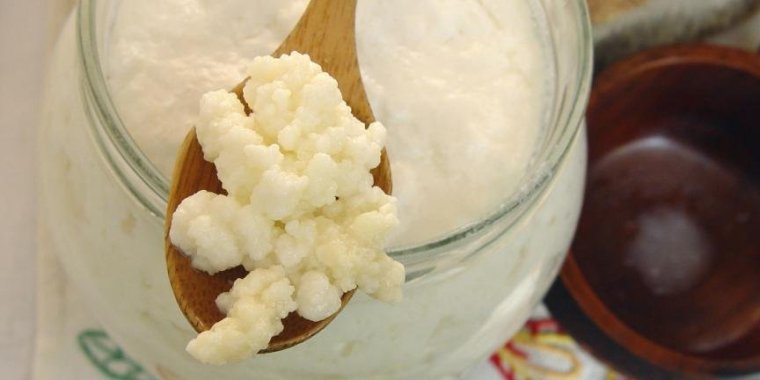| News / Science News |
Cooperation is key to success in microbial communities
The study used kefir as a model to study metabolic interactions within microbial communities. It is easy to grow, and consists of around 40 different species - providing a ‘Goldilocks zone’ of complexity that is not too small yet not too unwieldy to study in detail. Kefir is composed of ‘grains’ - resembling small pieces of cauliflower - that have fermented in milk to produce a probiotic drink composed of bacteria and yeasts.

Milk kefir grains with jar of kefir in background. ![]()
The researchers were surprised to discover that the dominant species of Lactobacillus bacteria found in kefir grains cannot survive on their own in milk. However, the different species work together, feeding on each other’s metabolites in the kefir culture to support each other.
“The kefir grain acts as a ‘base camp’ for the kefir community, from which microbes colonise the milk in a complex, yet organised and cooperative manner,” said Dr Kiran Patil, Director of Research at the University of Cambridge’s MRC Toxicology Unit, group leader at EMBL, and senior author of the study.
The researchers combined a variety of state-of-the-art methods including metabolomics (studying metabolites’ chemical processes), transcriptomics (studying the genome-produced RNA transcripts), and mathematical modelling.
This revealed not only key molecular interaction agents like amino acids, but also the contrasting species dynamics between the grains and the milk.
While scientists know that microorganisms often live in communities and depend on their fellow community members for survival, there was previously very little understanding of how this works. Lab models have historically been limited to two or three different microbial species.
“Kefir microbial communities have many member species, with individual growth patterns that adapt to their current environment. This means fast- and slow-growing species and some that alter their speed according to nutrient availability,” said Sonja Blasche, a postdoc in the Patil group at EMBL and joint first author of the paper.
Kefir is one of the world’s oldest fermented foods and has many purported health benefits, including improving digestion and lowering blood pressure and blood glucose levels.
This phenomenon of microbial cooperation is not limited to kefir. In another paper from Patil’s group, scientists combined data from thousands of microbial communities across the globe - from soil to the human gut - to understand similar cooperative relationships.
Advanced metabolic modelling showed that the co-occurring groups of bacteria are either highly competitive or highly cooperative. This stark polarisation has not been observed before and sheds light on evolutionary processes that shape microbial ecosystems.
While both competitive and cooperative communities are prevalent, the cooperators seem to be more successful: they are more abundant and occupy a more diverse range of habitats.
“We see this phenomenon in kefir, and then we see it’s not limited to kefir,” said Patil. “If you look at the whole world of microbiomes, cooperation is also key to their structure and function.” (University of Cambridge)
YOU MAY ALSO LIKE





